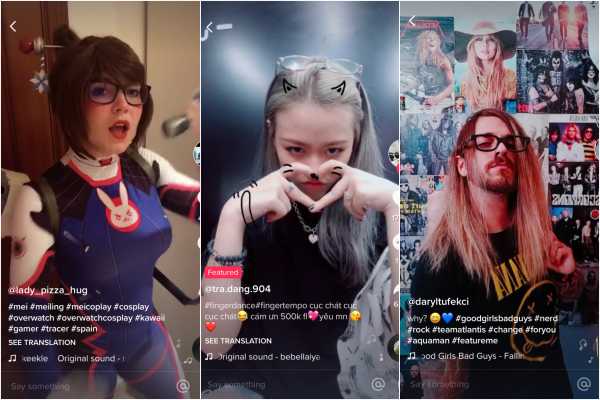
“Hey girl, you like me a little bit?” “Oh, you’re with her now?” “Why do good girls like bad guys?” These are questions young people have asked each other since the dawn of time, but on TikTok, they’ve turned into massively widespread memes set to music, reaching millions in every corner of the globe.
TikTok is one of the most popular — and most interesting — social media apps on the planet, but it has yet to enter the lexicon of most average Americans. The gist is this: Users film videos of themselves lip-syncing or acting out comedy sketches, up to 15 seconds long, and can choose from a database of songs, effects, or sound bites. Collaboration is a major incentive — you can do a “duet” with someone by replying to their video, which creates a split-screen diptych, thus feeding into an endless chain of reactions. Users can also upload their own sounds, so that it’s possible to lip-sync to someone else’s original video.
All of this makes TikTok extremely fun to use, and helps explain why it’s grown so massively: In September, it surpassed Facebook, Instagram, YouTube, and Snapchat in monthly installs in the App Store, and in July, TikTok hit 500 million global monthly active users, with 6 million US downloads as of November. It’s still only a fraction the size of Facebook (2.27 billion global monthly active users) and Instagram (1 billion), but it’s far ahead of Twitter (336 million) and Snapchat (186 million).
This has translated to enormous success for its parent company, ByteDance, which recently surpassed Uber as the world’s most valuable startup. At a valuation of more than $75 billion, it’s the first Chinese internet company with a “significant, genuinely engaged following around the world,” according to The Verge. On December 7, the tech site the Information reported that ByteDance was in talks to raise an additional $1.4 billion for investments in artificial intelligence and media content. TikTok itself has gotten so big that Facebook even quietly launched a competitor called Lasso in November.
TikTok, on the surface, doesn’t look so different from the litany of other video-centric social media apps that came before it, like Snapchat, Vine, or Dubsmash. It shares similar pitfalls (privacy, online creeps) and similar assets (like Vine, TikTok has created its own language of comedy), but thanks to its algorithm that makes binge-watching irresistible, as well as a sophisticated array of sound and visual effects, TikTok offers far more possibilities for creators.
For an app with such a simple mission — singing! dancing! to music! — being good at TikTok requires a surprising amount of practice. Many of its most popular videos are quite laborious to produce (here’s a tutorial that will show you how to take advantage of some of the app’s most useful features), but it’s also what’s made huge stars of its most skilled users: 16-year-old German twins Lisa and Lena (32 million fans), 18-year-old Baby Ariel (29 million fans), 16-year-old Loren Gray (29 million fans), and 16-year-old Jacob Sartorius (19 million fans), all of whom have released their own (non-lip-synced) singles since building huge followings on TikTok’s predecessor, Musical.ly.
What all this means is that TikTok isn’t just the latest app you need to pretend to have heard of to impress your teenage family members during the holidays — it’s one of the most important companies on the planet, and it’s at the forefront of the possible future of social media.
Where did TikTok come from?
First, here’s what TikTok is not: It is not in any way related to the 2009 Kesha song of the same name, nor is it the first extremely popular lip-syncing app. Indeed, it’s actually the second iteration of Musical.ly, an app that’s identical to TikTok in most major ways, and which was launched in 2014 by Chinese entrepreneurs Alex Zhu and Luyu Yang. Musical.ly was acquired for around $1 billion in November 2017 by the Beijing-based tech company ByteDance, which already owned the popular TikTok, a Muscial.ly equivalent (though in China, TikTok is called Douyin). In August 2018, TikTok absorbed Musical.ly, and all Musical.ly accounts were automatically migrated to TikTok.
Despite the app’s massive popularity and its parent company’s unprecedented valuation, celebrities have been strangely slow to get in on it. Jimmy Fallon, whose team introduces weekly games like the #TumbleweedChallenge, has a strong presence on the platform, while Amy Schumer recently uploaded her first TikTok in which she announced, “I can’t pass up a chance to be called ‘fat’ on a new social media network!” Tony Hawk, for whatever reason (his teenage children, perhaps), is also an OG TikTok user.
Along with an aggressive YouTube ad campaign, TikTok also appears to have spent money to get more celebrities on the app: Cardi B and Offset (RIP, love) hosted a sponsored holiday “wrap battle,” in which Awkwafina also participated, while Foodgod’s (née Jonathan Cheban) first video was also sponsored.
But TikTok is still primarily an app for normies. The act of scrolling through TikTok will transport you into the worlds of regular American teenagers whose videos have thousands of likes and hundreds of supportive comments. Multiple popular TikTok users I spoke to pointed to the astronomical views, comments, and likes that posts can garner — which easily eclipse those of Instagram, Snapchat, or Vine in its heyday — as one of the reasons they loved it, as well as the relative rarity of bullying and trolls that swarm other sites.
Though TikTok’s video view count is only available to the original poster, when videos end up on the “For You” page (that’s the home feed that showcases TikTok’s best content), they’ll receive anywhere from 50,000 to more than 1 million likes.
The New York Times has praised TikTok as “the only truly pleasant social network in existence” for its ad-free, news-free interface, while The Verge has defended it from critics as the “joyful, spiritual successor to Vine.”
TikTok is perfectly designed for our love of cringing
This, however, is not exactly the reputation that TikTok enjoys on the rest of the internet. My own entrée into TikTok culture came through compilations of the most cringe-inducing content on the app, which are among the first results you’ll get when you type “TikTok” into YouTube. To a generation of cynical internet users, TikTok videos are purely targets of ridicule.
Because when lots and lots of normal people use an app that’s essentially simulating karaoke — already an activity with a high possibility for humiliation — and then broadcast those videos to a potential audience of millions, not all of the results are going to be as pretty as a filtered, curated Instagram photo. The level of earnestness that many TikTok videos convey often crosses the line into cringeworthiness, particularly when it comes to very young teenagers exploring subcultures like furry fandom, infantilism, or certain kinds of cosplay.
It’s not just the users: Even the “challenges” themselves, or the many replicable memes that go viral on TikTok, are pretty corny. There’s the bizarre phenomenon of finger dancing, there’s the one where you’re supposed to lip-sync to a scene from Ice Age, the one where all you do is rotate your phone around in a circle, and my personal favorite, the “Why do good girls like bad guys?” meme, in which men attempt to transform themselves into “bad boys” while lip-syncing to a 2011 pop-punk song. It’s just a tiny sampling of the infinite feedback loop of challenges and memes within the TikTok ecosystem.
Teens, of course, should be allowed to experiment with whatever personal style they like, but unfortunately, that doesn’t protect them from ending up in one of YouTube’s many, many TikTok cringe compilations. These supercuts are entertaining, but they also often serve to shame users who look different from what we’re used to seeing featured on social media and in mainstream culture.
YouTube creators, meanwhile, have milked viewers’ interest in watching uncomfortable TikToks by making reaction videos with titles like “TikTok Must Be Stopped” and “TikTok Gamer Girls Should Be Illegal,” or any one of YouTube’s most-subscribed user PewDiePie’s five TikTok screeds (always the contrarian, he now seems to have decided that actually, TikTok is good).
Much like on Vine and Instagram, scripted comedy thrives on TikTok. Unfortunately, the thing about scripted comedy is that it’s hard to do well and incredibly unpleasant to watch when done poorly. Yet the way some TikTok users have attempted to circumvent this obstacle — by lip-syncing to scenes from film or TV, someone else’s standup (or someone else’s TikTok sketch), or worse, a viral tweet — is even cringier.
One example of the sort of just-add-water comedic memes common on the app is set to the song “Little Bit” by 15-year-old white rapper MattyBRaps, in which a boy acts out the lyric, “Hey girl, you like me a little bit?” and his female counterpart responds, “No, I don’t even like you a little bit.” This is the extent of the joke.
Didi Rio, a 15-year-old in Southern California, is among the users who only post original comedy rather than parroting other people’s content. He’s been on the app for just a month, yet he’s already amassed 30,000 fans with his high-energy, often meta video skits. “I think I would call my comedy style ‘boom, you didn’t see that coming,’” he tells Vox.
He says that while he’s encountered bullies on the site, he doesn’t let them get to him. “There isn’t a second anywhere in our world without them,” he says. “Luckily, love and kindness triumphs that, so it’s no big deal to me.”
The darker side of TikTok: creepy adults and sexist teens
Bullying, however, is likely not the biggest threat to TikTok. Though it only allows users who are 13 or older, like most apps, it’s not exactly a foolproof restriction. And also like most apps aimed at young people, TikTok is home to its fair share of creeps.
The South China Morning Post found that hundreds of Hong Kong children as young as 9 years old unwittingly exposed their full names, phone numbers, and schools by including the information in public videos. (On TikTok, videos can only be either private to one’s self or public to anyone on the app.) They also noted that many of these accounts received creepy messages from adults asking young girls to “be their girlfriend” or requesting their cellphone numbers.
This isn’t a new problem; in 2017 an ABC news segment told the story of an Indiana 7-year-old who was asked to send shirtless photos of herself by a stranger on Musical.ly. Around the same time, a 25-year-old Fresno, California, man was charged with sexual exploitation of children under 12 through Musical.ly and other apps.
In response to a Vice story on TikTok’s vast underbelly of accounts that try to solicit nudes from children, a TikTok spokesperson said that it has “a number of measures in place today to protect against misuse,” including a moderation team and the fact that photos and videos can’t be sent via direct message. The problem, though, is that many of these accounts are in all likelihood adults posing as fellow teenagers, making kids much more likely to hand over their phone numbers.
As one YouTube video points out in great detail, one of TikTok’s largest factions is very young girls mimicking thirst trap culture by posting provocative videos of themselves in risqué clothes. Besides potentially attracting pedophiles, this can make the experience of scrolling through TikTok as an adult deeply uncomfortable.
And although it certainly isn’t illegal to do so, the TikTok cringe compilator who runs the YouTube channel Randy Ronda told me that among the worst parts of TikTok is “the older men dueting underage girls.” For context, it’d be similar to an older man, say, commenting on the Facebook or Instagram of a teen girl he didn’t know. Also uncomfortable: the hordes of white teenagers putting on questionable affectations while lip-syncing to black artists.
One of TikTok’s most popular memes is also predicated largely on sexism. Gamer culture has never exactly welcomed women into its ranks, but when a clip from a song about the game Overwatch went viral on TikTok this fall, the “I’m already Tracer” meme — in which the female vocalist sassily declares that she’s chosen all the most powerful characters in the game, like Tracer, Widowmaker, and Winston — was quickly turned into a means of bullying girls.
As internet culture reporter Julia Alexander notes, the song “No Mercy” by the Living Tombstone, from which the “I’m already Tracer” clip originated, was a catchy, clever skewering of the idea that female gamers are automatically assumed to play as supporting characters (in this case, that’s Mercy). But when users uploaded videos of themselves lip-syncing to the song in which they, for instance, used the wrong controller or held it a certain way, others uploaded split-screen duets of the song in attempts to out the original poster as a “fake gamer girl,” a sexist character trope that’s among the most loathed on the internet.
TikTok is a hugely lucrative Wild West
Even though TikTok is an enormous network of inside jokes, reactions, reactions to reactions, and meta memeification, it’s still wildly underdeveloped. That’s because brands — omnipresent on Instagram, Facebook, and Twitter — have yet to truly sink their teeth in.
For users, that’s part of the appeal, and what makes the experience of using TikTok feel so authentic. But it’s only a matter of time before that changes — so for creators, these are boom times.
Drea Knows Best, a comedy creator with more than 1.8 million fans, says the biggest distinction TikTok has from other social media apps is its highly loyal and hugely active audience. Though she was already popular on Muscial.ly and Vine before they were shut down, “the engagement on TikTok is unreal,” she tells me.
Though she says she currently makes the majority of her income on TikTok through partnerships with brands like Netflix, she knows there are even more opportunities on the platform for both creators and the companies they work with. “The demographic is growing; it’s no longer like how it was on Musical.ly, where it’s all kids. All the creators on the app have very loyal fans. If they say, ‘Hey, guys, I’m partnering with Burger King, everyone go to Burger King and buy a burger,’ they will go to Burger King and buy a burger because they trust the influencers on TikTok and they’re loyal to them. It’s just phenomenal.”
TikTok had its highest-earning month to date in October, thanks to growing its in-app purchases by about 275 percent, according to the app business insights blog Sensor Towers, translating to more than $3.5 million worldwide. In-app purchases on TikTok are limited to “coins,” which people can use to send virtual gifts worth actual money to their favorite TikTok personalities during live broadcasts, which acts as another revenue source for creators like Drea.
Drea currently works with the digital talent agency Collab while also pitching herself directly to brands. She’s found success on the app in other ways, too: She’s currently enrolled in an entrepreneurial program at USC after winning a free semester there through Musical.ly.
Didi, a 15-year-old creator, could be next. “I see working in entertainment in the future as something I would totally enjoy big-time,” he says, “but I haven’t been approached by any entertainment professionals through TikTok yet. Talent pros, if you’re reading, I’m a great boy, hit me up.”
If they’re been paying attention to the rapid rise of TikTok, they probably will.
For now, TikTok feels like an escape from all the worst parts of more established social media apps. But as more brands inevitably tap into the hugely enthusiastic market waiting there, it’s possible that TikTok could either go the way of Instagram (covered in ads, sponsored content, and people in general taking themselves much too seriously), Snapchat (slowly dying), or Vine (brutally murdered before its time).
The best thing TikTok currently has going for it is its goofiness: Sure, the most popular TikTok celebrities can eventually shill products or launch actual music careers, but the vast majority are there to make silly lip-sync videos, fool around with visual effects, and participate in whatever challenge happens to be going viral at the moment. If social media is ever going to feel less like a chore, then TikTok is the leading the way.
Sourse: vox.com






